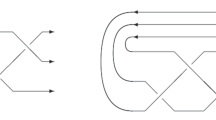Abstract
The eigenvalue hypothesis claims that any quantum Racah matrix for finite-dimensional representations of \(U_q(sl_N)\) is uniquely determined by eigenvalues of the corresponding quantum \(\mathcal {R}\)-matrices. If this hypothesis turns out to be true, then it will significantly simplify the computation of Racah matrices. Also, due to this hypothesis various interesting properties of colored HOMFLY-PT polynomials will be proved. In addition, it allows one to discover new symmetries of the quantum 6j-symbols, about which almost nothing is known for \(N>2\), with the exception of the tetrahedral symmetries, complex conjugation and transformation \(q \longleftrightarrow q^{-1}\). In this paper, we prove the eigenvalue hypothesis in \(U_q(sl_2)\) case and show that it is equivalent to 6j-symbol symmetries (the Regge symmetry and two argument permutations). Then, we apply the eigenvalue hypothesis to inclusive Racah matrices with 3 symmetric incoming representations of \(U_q(sl_N)\) and an arbitrary outcoming one. It gives us 8 new additional symmetries that are not tetrahedral ones. Finally, we apply the eigenvalue hypothesis to exclusive Racah matrices with symmetric representations and obtain 4 tetrahedral symmetries.
Similar content being viewed by others
Notes
All parameters, corresponding to the second matrix we will label by \(\ \tilde{ }\).
\(R_i=[r_i], \ \widetilde{R}_i=[\widetilde{r}_i]\)
References
Freyd, P., Yetter, D., Hoste, J., Lickorish, W.B.R., Millett, K., Ocneanu, A.: A new polynomial invariant of knots and links. Bull. Am. Math. Soc. 12, 239–246 (1985). https://doi.org/10.1090/S0273-0979-1985-15361-3
Przytycki, J.H., Traczyk, P.: Invariants of links of Conway type. J. Knot Theor. 4, 115–139 (1987). https://doi.org/10.1142/S0218216513500788. arXiv:1610.06679
Satoshi Nawata, Ramadevi, P., Zodinmawia: Colored HOMFLY polynomials from Chern–Simons theory. J. Knot Theor. 22, 1350078 (2013). https://doi.org/10.1142/S0218216513500788. arXiv:1302.5144
Yu, N., Turaev, V.G.: Ribbon graphs and their invariants derived from quantum groups. Commun. Math. Phys. 127, 1–26 (1990). https://doi.org/10.1007/BF02096491
Kirillov, A.N., Reshetikhin, N.Y.: Representations of the algebra \(U_q(sl(2))\), \(q\)-orthogonal polynomials and invariants of links. In: New Developments in the Theory of Knots, pp. 202–256. World Scientific, 1990. https://doi.org/10.1142/9789812798329_0012
Rosengren, H.: An elementary approach to 6j-symbols (classical, quantum, rational, trigonometric, and elliptic). Ramanujan J. 13, 133–168 (2007). arXiv:math/0312310
Freidel, L., Louapre, D.: Asymptotics of 6j and 10j symbols. Class. Quant. Grav. 20, 1267–1294 (2003). https://doi.org/10.1088/0264-9381/20/7/303. arXiv:hep-th/0209134
Teschner, J., Vartanov, G.: 6j symbols for the modular double, quantum hyperbolic geometry, and supersymmetric gauge theories. Lett. Math. Phys. 104, 527–551 (2014). https://doi.org/10.1007/s11005-014-0684-3. arXiv:1202.4698
Liu, J., Perlmutter, E., Rosenhaus, V., Simmons-Duffin, D.: \(d\)-Dimensional SYK, adS loops, and \(6j\) symbols. JHEP 03, 052 (2019). https://doi.org/10.1007/JHEP03(2019)052. arXiv:1808.00612
Saswati, D., Mironov, A., Morozov, A., Morozov, A., Ramadevi, P., Vivek Kumar, S., Sleptsov, A.: Multi-Colored Links From 3-strand Braids Carrying Arbitrary Symmetric Representations. Ann. Henri Poincare, 2019. arXiv:1805.03916https://doi.org/10.1007/s00023-019-00841-z
Alekseev, V., Morozov, A., Sleptsov, A.: Multiplicity-free \(U_q(sl_N)\) 6-j symbols: relations, asymptotics, symmetries. Nucl. Phys. B 960, 115164 (2020)
Mironov, A., Morozov, A., Morozov, A.: Character expansion for HOMFLY polynomials. II. Fundamental representation. Up to five strands in braid. JHEP 03, 034 (2012). https://doi.org/10.1007/JHEP03(2012)034. arXiv:1112.2654
Itoyama, H., Mironov, A., Morozov, A., Morozov, A.: Eigenvalue hypothesis for Racah matrices and HOMFLY polynomials for 3-strand knots in any symmetric and antisymmetric representations. Int. J. Mod. Phys. A28, 1340009 (2013). https://doi.org/10.1142/S0217751X13400095. arXiv:1209.6304
Mironov, A., Morozov, A.: Universal Racah matrices and adjoint knot polynomials: arborescent knots. Phys. Lett. B 755, 47–57 (2016). https://doi.org/10.1016/j.physletb.2016.01.063. arXiv:1511.09077
Anokhina, A., Morozov, A.: Cabling procedure for the colored HOMFLY polynomials. Teor. Mat. Fiz. 178, 3–68 (2014). https://doi.org/10.1007/s11232-014-0129-2. arXiv:1307.2216
Saswati Dhara, Mironov, A., Morozov, A., Morozov, A., Ramadevi, P., Vivek Kumar Singh, Sleptsov A: Eigenvalue hypothesis for multistrand braids. Phys. Rev D97(12), 126015 (2018). https://doi.org/10.1103/PhysRevD.97.126015. arXiv:1711.10952
Bishler, L., Morozov, A., Sleptsov, A., Shakirov, S.: On the block structure of the quantum \(\cal{R}\)-matrix in the three-strand braids. Int. J. Mod. Phys A33(17), 1850105 (2018). https://doi.org/10.1142/S0217751X18501051. arXiv:1712.07034
Mironov, A., Morozov, A.: Eigenvalue conjecture and colored Alexander polynomials. Eur. Phys. J. C 78(4), 284 (2018). https://doi.org/10.1140/epjc/s10052-018-5765-5. arXiv:1610.03043
Mishnyakov, V., Sleptsov, A.: Perturbative analysis of the colored Alexander polynomial and KP soliton \(\tau \)-functions. Nucl. Phys. B 965, 115334 (2021). https://doi.org/10.1016/j.nuclphysb.2021.115334
Mishnyakov, V., Sleptsov, A., Tselousov, N.: A new symmetry of the colored Alexander polynomial. In: Annales Henri Poincaré, pp. 1–31. Springer, (2021)
Mishnyakov, V., Sleptsov, A., Tselousov, N.: A novel symmetry of colored HOMFLY polynomials coming from \(\mathfrak{sl}(N|M)\) superalgebras. arXiv:2005.01188, (2020)
Morozov, A., Sleptsov, A.: New symmetries for the \(U_q(sl_N)\)\(6\)-\(j\) symbols from the Eigenvalue conjecture. JETP Lett. 108(10), 697–704 (2018). https://doi.org/10.1134/S0021364018220058. arXiv:1905.01876
Klimyk, A., Schmudgen, K.: Quantum Groups and Their Representations. Springer, Berlin (1997)
Jie, G., Jockers, H.: A note on colored HOMFLY polynomials for hyperbolic knots from WZW models. Commun. Math. Phys. 338(1), 393–456 (2015). https://doi.org/10.1007/s00220-015-2322-z. arXiv:1407.5643
Mironov, A., Morozov, A., Andrey, M.: Character expansion for HOMFLY polynomials. I. Integrability and difference equations. In Anton, R., Ludmil, K., Johanna, K., Radoslav, R., Emanuel, S (eds.), Strings, gauge fields, and the geometry behind: The legacy of Maximilian Kreuzer, pp. 101–118. 2011. arXiv:1112.5754, https://doi.org/10.1142/9789814412551_0003
Biedenharn, L., Schwinger, J., Van Dam, H.: Quantum theory of angular momentum (1965)
Fulton, W., Harris, J.: Representation Theory: A First Course. Springer, Berlin (1991)
Nawata, S., Ramadevi, P.Z.: Multiplicity-free quantum 6\(j\)-symbols for \(U_{q}(\mathfrak{sl}{_N})\). Lett. Math. Phys 103, 1389–1398 (2013). https://doi.org/10.1007/s11005-013-0651-4
Acknowledgements
Our work was partly supported by the grant of the Foundation for the Advancement of Theoretical Physics “BASIS” (A.M., A.S. and A.V.), 17-01-00585 (A.M.), 18-31-20046 (A.S.), 19-51-50008-Yaf-a (A.M.), 18-51-05015-Arm-a (A.M, A.S.), 18-51-45010-Ind-a (A.M, A.S.), 19-51-53014-GFEN-a (A.M, A.S.), 20-01-00644 (A.M., A.S. and A.V.), by President of Russian Federation grant MK-2038.2019.1 (A.M.). The work was also partly funded by RFBR and NSFB according to the research project 19-51-18006 (A.M.). On behalf of all authors, the corresponding author states that there is no conflict of interest.
Author information
Authors and Affiliations
Corresponding author
Additional information
Publisher's Note
Springer Nature remains neutral with regard to jurisdictional claims in published maps and institutional affiliations.
Rights and permissions
About this article
Cite this article
Alekseev, V., Morozov, A. & Sleptsov, A. Interplay between symmetries of quantum 6j-symbols and the eigenvalue hypothesis. Lett Math Phys 111, 50 (2021). https://doi.org/10.1007/s11005-021-01386-1
Received:
Revised:
Accepted:
Published:
DOI: https://doi.org/10.1007/s11005-021-01386-1



